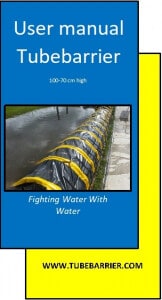The installation of the Tubebarrier is simple, fast and can be installed almost anywhere.
The Tubebarrier flood defences is delivered per 10 meter element complete in a pallet box, which contains everything you need for the installation of the weir.
Every situation is different and therefore the set up of the weir varies. But globally, you place the pallet boxes every 10 meters and draw the elements out of the boxes, just so that the sides of the Tubebarriers meet. The elements are connected to each other. Also there is a flap that one draws over the connection. This in order to neatly close it all. By doing this you have connected the two elements. Repeat this process with the other elements.
You are able to do this with 2 people. You can easily do the flood defences barrier installation with a four people. Overall you can install a 100 meters of weir per hour when all elements are in place. We also have a frequently asked questions page where you can find lots of information regarding installation of the Tubebarriers.
Flood Barrier installation Step by Step
Step 1) positioning storage boxes:
The storage boxes can store one section of 10 meter complete with all the needed mounting parts to fix the Tubearrier to the surface. Position these boxes at the deployment location at a distance, of 1 meter less than the length of te stored section. Remove all loose parts from the box and place them next to the box on the ground (On the side where the front flap points, the water). Tilt the storage box so that the bottom of the barrier points down and front flap points towards the water.
Step 2) deploying the Tubebarrier(s):
Inspect the surface where the flood defences will be deployed and make sure there are no sharp objects on this surface as these can damage the PVC fabric.
Now pull the Barrier apart like an accordion, just as far as it is tight. If the end of the first Section is not mounted against a wall (i.e. is free standing), it must be above the expected water level so that the water cannot run around the end. In case of strong winds, it is possible to secure the front flap with the supplied pin pegs. There are rings in the front flap where you can press the pegs into the ground. You can also lock the barrier in the rear.
With the second section (and any following sections) you have to make sure that when you pull the section apart, the side of this section is tight against the previous section.
Step 3) Connect the Tubebarrier units together:
When the ends of the two sections are tight against each other, you connect both sections with a zipper and a flap with Velcro. The zipper can only be zipped from one side, from the front flap towards the tunnel. Before you attach the finishing flap with Velcro over the zipper, it is important to first tighten the current section to ensure that the flap is tight. Now pull the protective flap over the zipper and press it firmly onto the Velcro. The zipper is now protected against dirt and damage.
Step 4) Attaching the ground anchor plates: We have different kind of ground anchors, for every situation one, sometimes more.
Step 5) Mount the ground anchors of the first section correctly to the surface when the second section is equipped with ground anchors (and so on). For more information, please send an email to info@tubebarrier.com.
Step 6) Storm flap and final check:
 At the rear of the Barrier is a small storm flap. This flap is equipped with rings where you can insert the supplied pin pegs to secure the flap. You can also weight the back flap with material that is present (e.g, sandbags, tiles or stones etc.)
At the rear of the Barrier is a small storm flap. This flap is equipped with rings where you can insert the supplied pin pegs to secure the flap. You can also weight the back flap with material that is present (e.g, sandbags, tiles or stones etc.)
- When a section is fully assembled, it is best to do a final check.
- Every barrier is properly connected to each other.
- The front flap is nice and tight and not wrinkled.
- The entire front has ground anchors and is it securely attached.
- Pay attention to any damage to the material.
- Remove all loose material and tools etc. around the barrier.
- Ensure adequate supervision.
Side Walls of our Flood Tube Barrier
When you have to place the Tubebarrier against a wall or berm, special side wall pieces are available. These side walls consist of the same material as the Tubebarrier itself. There is a left and a right version of the side walls available. These side walls ensure that there is no or little water between the wall (or wall) and the barrier runs to the dry side.
Just like the installation of the ground anchors, it is best to pre-install. The side walls are zipped together with a zipper and Velcro (same as the connection of the Sections), this is only possible in one way. Which steps do you need to take in advance to make a correct connection?
- Place Tubebarrier ends in the correct location and position it so that the side of the barrier touches the wall.
- Zip the side wall on the side of the Tubebarrier.
- Slide the supplied mounting plate (same type as the ground anchor) over the string on the side wall.
- Ensure that the ground anchors on the ground are in line with the mounting plate of the side wall.
- Mark at least 3 points where you can place the pre-installed bolts. Make sure that the side wall is not too loose or too tight.
- Check whether the bolts are in the correct location and screw the mounting plate from the side wall onto the
- When everything has been approved, unscrew the mounting plate and screw the bolts back into the wall.
Less maintenance flood barrier & well prepared for an emergency.
MAKING A CORNER OR CURVING THE WATER BARRIER
If you want to create a bend or curve in the barrier, this is certainly possible. Tubebarrier is a flexible barrier that goes smoothly on surface, and can also be placed around obstacles quite easily with bends or curves.
Slight turn
A slight turn can easily be made by bending the Barrier. What should be noted is that the front flap stays tight on the floor and does not rise. Care must be taken that the ground anchors can be mounted properly. If there is some room in the front flap due to the (inside) bend (folds), we recommend that the fold be brought in, so it falls under the flap when possible. Try to connect the base plates as tightly as possible.
90 degree angle flood defences
You can simply order an internal or external 90 degree bend. You then order a pre-prepared section of 10 meters with a bend. The links with zipper and the ground anchorage remain the same as the standard Sections.
We recommend that you pre-install the corners when there is no calamity. In this way you can mark the corners and install all ground bolts in advance. This way you will be less likely to be confronted with surprises.
Example: a building that you want to protect all around with a paved surface;
Step 1. Place the 4 x 90 degree corner elements loose on each corner of the building. If you have the option, we recommend placing the barrier at a reasonable distance from the building.
Step 2. Place the straight sections loosely between the corner elements, move these corner elements so that they fit nicely with the straight sections.
Step 3. Now connect all elements together with the zipper and Velcro.
Step4. Tighten the barriers so that there is no or little space left under the front flap. Check everything carefully and see if the barriers are in the right place.
Step5. Now slide the ground anchors onto the front flap so that the entire front flap has ground anchors.
Step6. Pre-drill the holes for the ground bolts and drill them into the ground. Adjust all base plates to see if they can be mounted properly and the holes correspond.



